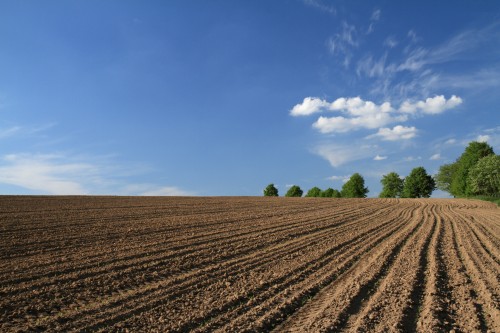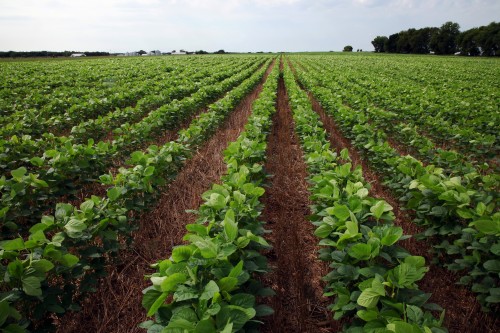 In the late 1960s, when North America was first wising up to pollution, a group of progressive farmers resolved to do their part. Phosphate levels in nearby lakes were promoting blue-green algal blooms, excessively nourishing the cyanobacteria. The blooms consumed oxygen in the lakes, and massive fish kills followed.
In the late 1960s, when North America was first wising up to pollution, a group of progressive farmers resolved to do their part. Phosphate levels in nearby lakes were promoting blue-green algal blooms, excessively nourishing the cyanobacteria. The blooms consumed oxygen in the lakes, and massive fish kills followed.
While it was easy to blame untreated sewage that spewed into most water bodies in populated areas at the time, there was a clear contribution from fertilizers high in phosphorus. When storms pelted the shoreline farmland, particulate phosphorus would wash down unguarded inclines along with much of the freshly-tilled soil. Erosion wasn’t just bad for the environment, it was costly and bad for crop health.
Along came no-till farming.
Instead of disturbing and opening the earth all over a field until it is vulnerable to erosion, no-till farming only opens ground for the purposes of planting. To make up for the lower absorption capacity of intact ground, farmers line up crop residue to create water channels.

Cheaper, cleaner, conserving of soil and nutrients – all around a more natural way to grow food. The idea spread to its current peak, with no-till farming methods used on more than 80% of Canadian seeding land today.
And it seemed to be working. Lake water particulate phosphorus loads did, indeed, go down and aquatic ecosystems recovered over subsequent decades. But then in the mid-1990s the algal blooms began mysteriously to return. Lake Erie, recipient of waters from the Detroit river and Ohio watersheds, has suffered two massive blooms in its western basin in the last five years.
All this time, no-till farms have been releasing more dissolved, reactive phosphorus than their conventionally-tilled equivalents that washed particulate phosphorus into the lakes. When fertilizer is broadcast onto un-tilled soil it tends to stay on top and the absorption of the top layer is quickly saturated. This in contrast to tilled soil that churns fertilizer down into the mix. When heavy rains hit during planting season, the plant residue channels provide easy waterslides for dissolving fertilizers to slide right into the drainage tiles.
Tillage methods may have been wrongly accused all along. The real culprit looks like over-application of the wrong fertilizers at times when they won’t quickly be taken up by the plants. Less than 20% of the phosphorus applied is actually used by the crops, and as a result most agricultural soils are excessively saturated in the stuff. Experimental fields in the Lake Simcoe watershed are being used to compare methods, in a study that’s set to wrap up in 2021 with ten years of data.
It’s always jarring to find out something natural is worse for us than something artificial. That our built environment is so pervasive that nature’s default systems are inappropriate and artificial solutions are the only recourse for artificially-created problems. Mother nature knows how to balance and settle her own creations, but it seems she’s not particularly interested in other people’s brainchildren.
Great, until the last paragraph. I’m not sure if you’re just decrying that we can’t get out of our own way to save our backsides, or actually trying to say something like “Well, that didn’t work, back up and try again.” I hope it’s the former.
In other production systems (say, semiconductors), if it isn’t measured, we’re just guessing what effect our changes have on the process. So if the soil isn’t measured periodically (and the air, and the plants, and the resulting products), and adjusted to some optimal profile, it doesn’t really matter what we do with it, because it is most likely wrong in a number of ways. (“Optimally” might be complex, balancing output, time, cost, complexity, effort, sustainability, and environmental impact.)
Yes, the former — and you expressed it better than I. In fact, I am sorely tempted to go in and change the last paragraph to read, “So apparently, we can’t stay out of our own way to save our backsides.”
But what about erosion? No-till was offered as a solution to at least two problems, arguably of equal importance–fertilizer runoff and soil erosion. Perhaps it doesn’t work as well as promised in controlling the first, but is there evidence it doesn’t control the second? Seems there are other answers to the fertilizer runoff problem than just saying “no-till doesn’t work.”
The problem is the fertilizer application method. No-Till farmers on the Canadian Prairies stopped broadcasting fertilizer a long time ago. Broadcasting fertilizer is very in efficient, especially phosphorus since it is not a mobile nutrient. Finding a way to band fertilizer in the soil preferably below the seed in the root zone is much more efficient and it would eliminate the runoff issue for the environment.
Yes, absolutely. It all depends on the parameters of the problem, and it could well be that no-till is overall the best approach, but that in fact the phosphorus issue lies outside of the till/no-till question.
Sorry Pat, that was meant as a reply to Peter. I had come across literature about banding fertilizer as an alternative to broadcasting it, and then I decided I didn’t yet understand it well enough to write about it this week. But the way you explain it makes a lot of sense.
The bio humic soil building non chemical farm method solves the chemical air, water, run off and soil erosion problems . Healthy soil ,healthy seeds, healthy plants, healthy people , healthy environment. The agriculture experiment represents 1% of our species time on the planet. Economics ,populations pressure , health and food secure may rely heavily on how fast we see this experiment is not working . What chemicals do to the soil , our health and the environment is a story yet to be told…and realized.
I agree with Peter’s comments No-till offers so many benefits for the soil, the environment and society I would hate to see you throw out the baby with the runoff water so to speak. Long term (25-30 years) No-till proven to greatly improves soil quality. The undisturbed plant material on the soil surface not only protects the soil from erosion it gets us back to a naturally occurring mulch layer that builds soil organic matter over time. This building of organic matter insures long term soil quality for generations. Building organic matter in the soil is done by taking CO2 out of the air and turning it into organic carbon in the soil, improving air quality also. Other benefits are reduced use of fossil fuels and reduced input costs to growers for their economic sustainability. Over the last 30 years No-till has not only stopped the destruction of millions of acres of marginal soil in the world it has also improved the soil quality and environment at the same time.
Joan, in the interest of hungry people all over the world I will go with our successful No-Till soil building experiment over the last 30 years. It is the most productive cost effective way to produce food we have today.